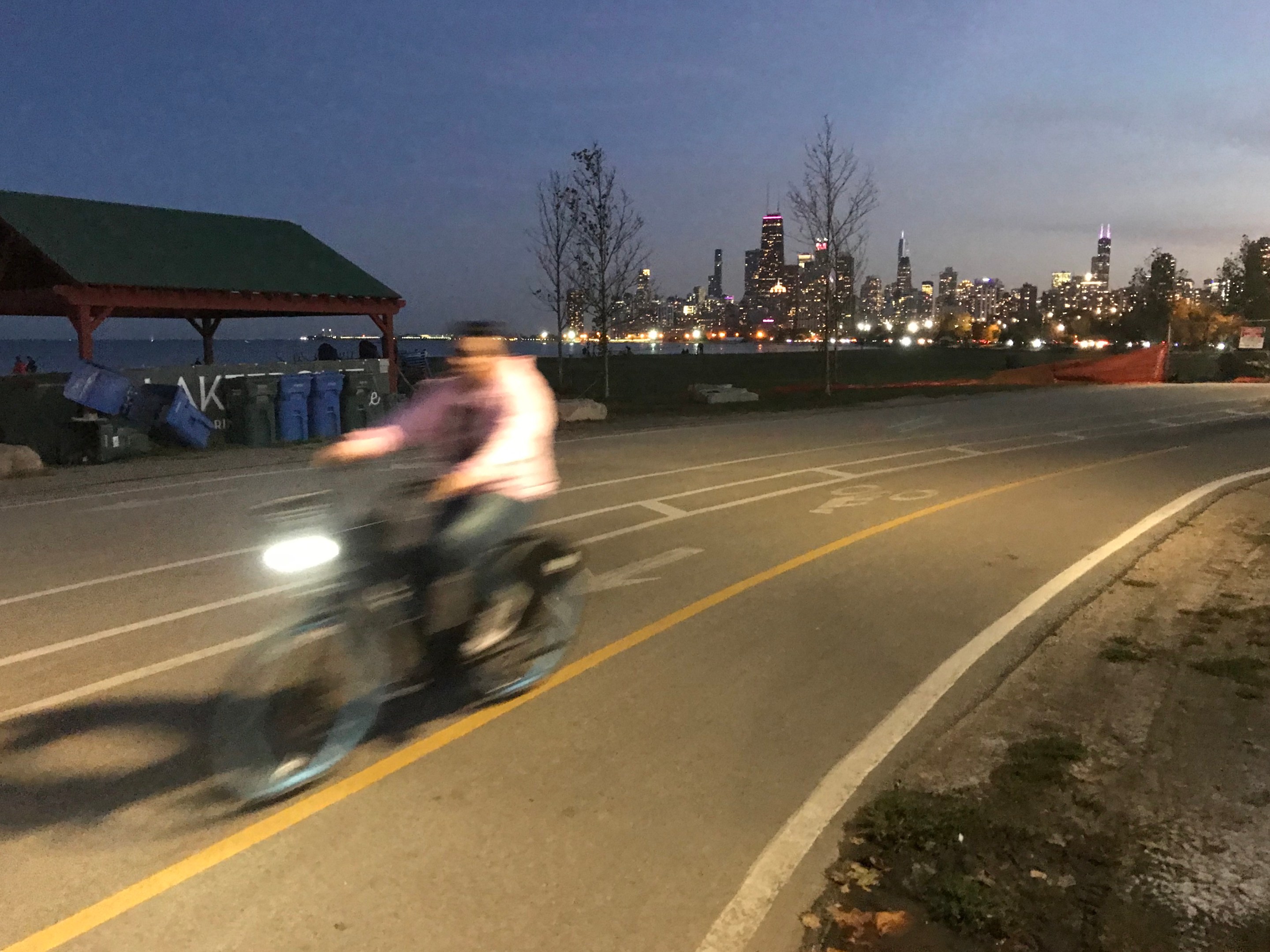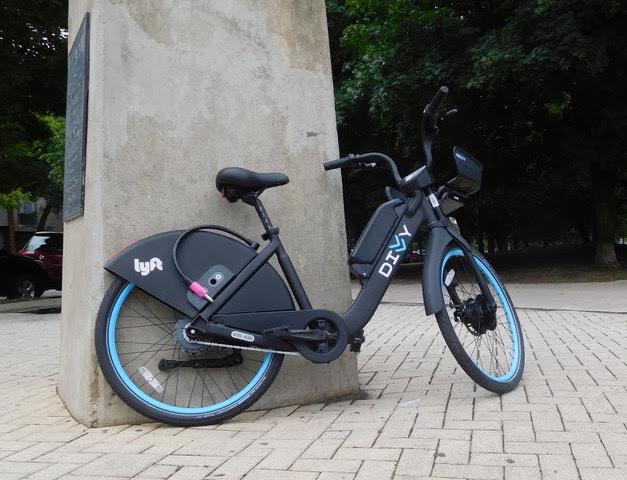Love 'em or hate 'em, electric-assist Divvy bike-share cycles are here to stay. The black bikes, which debuted on July 29 of this year are ubiquitous in much of Chicago, and you don't have to hang out for long on a busy cycling street or off-street path before you spot a rider on one, effortlessly zipping along at some 15 mph.
There are many arguments in favor of this new-ish technology. Most importantly, they're helping to improve bike equity. On the Far South Side, bike advocates like Deloris Lucas, leader of the Golden Gate-based cycling and fitness group We Keep You Rollin' have tirelessly lobbied and waited for years for bike-share access. Deploying the e-bikes, which can be parked at any bike rack or pole, is allowing the Chicago Department of Transportation and Lyft, the Divvy concessionaire, to expand the service area without having to install lots of new stations during a time when federal funds for bike infrastructure are in short supply.
The electric assist is particularly handy in South and West side communities with a lower density of people and destinations, helping to improve transportation access in transit and retail deserts. The new pricing system, while rather complex, is generally equitable, since there are no surcharges to use the e-bikes west of Western Avenue and south of Pershing Road, parts of town where Divvy stations are typically spaced farther apart, and residents are more likely to have lower incomes.
But even if you live in a part of town with convenient Divvy station access, where you have to pay a per-minute fee for the relative luxury of using an e-bike, as well as a surcharge for the convenience of parking it right at your destination, rather than using a station and walking a block or two there, there's a lot to like about this new option. For a modest fee, most people can significantly shorten their usual trip lengths. When you're running late for an appointment or meeting (remember those?), it's great to be able to "bend time" and show up when you're supposed to by using a black bike instead of a blue one. As a bonus, you probably won't have to worry about showing up sweaty.
And, let's face it, effortlessly zooming down city streets at something like 50 percent of your usual speed can be really fun. But with that power comes an increased responsibility to travel safely and considerately.
Tragically, in September a 28-year-old man on an electric-assist Divvy lost his life when a driver struck him near the United Center. All the details of the case weren't immediately available. However, it's sobering to think that, while there was only one fatality within the first seven years of the bike-share program, the first e-Divvy death occurred only six weeks after the black bikes debuted.
And while the possible danger posed to others by an electric bike is exponentially lower than that of a car or truck, it's still important to keep in mind that e-Divvy are both faster and heavier than a typical bicycle. So it's especially important to be mindful of other people walking and cycling, because there's a greater potential for serious injuries in the event of a crash.
With these things in mind, here are some ideas for to help keep yourself and other people walking, biking, and driving safe when you ride an electric Divvy, as well as courtesy tips to help spread good vibes.
- While the electrical assist is supposed to cut off at 15 mph, my sense is that it's not difficult to ride faster than that, a major increase if, like me, your cruising speed is normally about 10 mph. Things will be coming at you much faster than you're used to, such as potholes, opening car doors, and other hazards, so it's even more important than usual to stay alert.
- As such, even if you don't normally wear a helmet when using bike-share, it's not a bad idea to use a helmet when you ride an electric cycle.
- Most urban cyclists generally treat stop signs like yield signs, and stoplights like stop signs, a logical style of riding known as the "Idaho stop" because it has long been legal in the Gem State, which has also recently been fully or partially legalized in Arkansas, Washington, Oregon, and Colorado. But on an e-bike it's especially important to execute your Idaho stops with consideration for others. Resist the temptation to blast through stop signs, instead slowing down enough to look both ways to ensure the coast is clear before proceeding, and be ready to stop for cross traffic or pedestrians, who will be understandably angry if they have to stop in their tracks to avoid a collision. At red lights, be sure to come to a complete stop and check in both directions before continuing through the intersection.
- While it's legal to ride electric Divvies in bike lanes (although, at e-bike speeds, it's especially important to ride in the lefthand portion of the bikeway to avoid getting doored), don't buzz (pass too close at high speed) other cyclists when passing them, which is sure to make them resent you. Either slow down to close to their speed before passing, or else check over your left shoulder for oncoming traffic, and then move left into the travel lane to give the other rider plenty of room.
- Speaking of which, it's legal to ride a bike in the center of the travel lane, aka "taking the lane," if you're keeping up with other traffic. That isn't that hard to do on city streets in moderate traffic when you're on an electric Divvy. So if you're hauling ass on an e-Divvy, taking the lane is a good riding strategy to reduce the chance of conflicts with folks on non-electric bikes. It's also fairly safe, since the always-on flashing taillight on your bike-share cycle makes it unlikely a motorist will fail to notice you and hit you from behind. When riding this way, I like to check over my shoulder now and then for drivers approaching me from behind, and if I see one temporarily shift to the right, riding in the bike lane if there is one, to let them pass. (On the other hand, if there's a line of slowed or stopped cars in front of you, it's also legal to move to their right in order to pass them.) So if you're comfortable taking the lane, go ahead and channel your inner John Forester, minus the crankiness and hatred of dedicated bikeways.
- Finally, when riding on popular off-street paths like the Lakefront Trail or The 606 during busy times, keep in mind that you won't be able to ride as fast as you'd like to, and you'll often need to slow down to safely navigate the two-wheeled path traffic. Doing otherwise is dangerous and selfish and will make other path users hate you. That's a good way to get branded a "Lakefront (or Logan Square) Lance," even though you're riding an e-Divvy rather than a Colnago road bike -- no Lycra required.
All right, that's my advice for staying safe and increasing the peace on an electric Divvy. Feel free to share any additional tips in the comment section.





